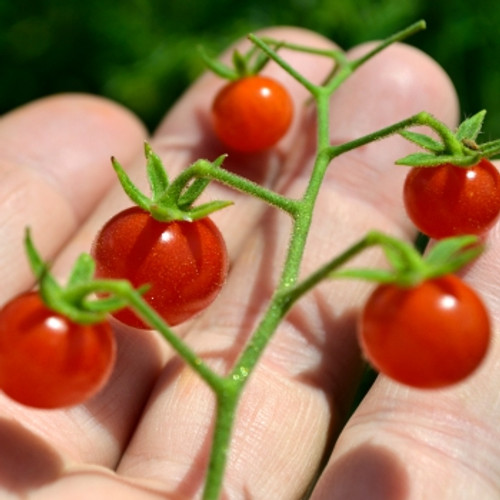Amish Paste Tomato Seeds - (Lycopersicon lycopersicum)
- SKU:
- V1141
- Seed Count:
- Approx 25 seeds per pack
- Days to Maturity:
- 75-85 days
- Type:
- Indeterminate
- Size:
- Plum
- Color:
- Red
- Days to Germination:
- 5-7 days @ 75-95F
- Light Preference:
- Full sun
- Plant Spacing:
- 12"
- Status:
- Heirloom, Non-Hybrid, Non-GMO seeds
Description
Amish Paste Tomato - Versatile Wonder
Plants are laden with whopping clusters of deep red, one pound, acorn or heart shaped fruits that have thick, sweet flesh with few seeds. Grows tall, needs staking or good support.
Late 1800s Amish heirloom from Lancaster, Pa., via Wisconsin.
Great sauce tomato, sweet and heavy yielding. Also good for slicing and drying. Exceptional for salsas.
History
Tomatoes were grown as a crop in Mexico and Peru in pre-Columbian times, but the early history of domestication is not well known (most likely in Mexico). In Europe, tomatoes were grown as ornamentals (thought to be poisonous) and became popular as a food only in the 18th century.
Uses
Raw or cooked the tomato is one of the most widely used and versatile foods from your garden. Use fresh in salads, sandwiches, and salsas. Cooked in sauces and stews. Can be stuffed, dried, puree, paste or powdered. The uses are endless!
Growing Tip
Tomatoes take about 3 - 4 months from direct seeding in the garden to start producing fruit; about 70 days from transplanting 6 - 8 week-old plants to start fruiting; and about 40-50 days from the flower opening to producing ripe fruit.
Tomatoes suffer more transplant shock than other vegetables, but you can minimize this by hardening them off for a week or two first. This means setting them outdoors in their pots in a protected place so that they get some warm sun, a little gentle wind, and even some cool (not freezing) nights. This will help them adjust to some of the stresses of real life before having their roots transplanted into the ground.
Tomatoes begin the ripening process by producing ethylene, a natural growth regulator, and releasing it. The fruit ripens from the inside out, meaning the center matures and turns red before the color reaches the outer skin. Faint white lines crossing each other at the bottom or blossom end of the fruit show that ripening has begun. Soon afterward, the blossom end starts turning pink – indicating ethylene is being produced. When the pink blush reaches the stem, the fruit is about 75% ripe. The pink color deepens to red, starting from the blossom end and working its way upward.
Harvest Tip
A tomato’s flavor increases as it ripens, due to the increased nutrients and sugars pumped into the fruit by the plant. For a home gardener, harvesting when there is just a touch of pink at the stem end or when the fruit is completely red gives the best flavor. The fruit will be fragile, won’t tolerate shipping and must be used or cooked within a few days to enjoy peak flavor.
Once the tomato is ripe, test by giving it a gentle pull or twist. If it slips easily from the vine – with little to no effort – it is ripe, juicy, and delicious!
Ripe tomatoes can be injured by cool temperatures and must be stored at room temperatures, never refrigerated to avoid chilling injury, which leaves pockmarks or pits on the skin leading to early rotting.
If you need to harvest early due to weather or the end of the season, those fruits with a pink blush at the blossom end will ripen with almost full flavor. Those with the faint white lines can still ripen but won’t have the full flavor.
Learn More
- Growing Tomatoes 101
- Determinate and Indeterminate Tomatoes - What's the Difference?
- Heirloom Tomato Growing Tips
- Heirloom Tomato Leaves - Potato Leaf vs Regular Leaf
- Blossom End Rot - What To Do
- Fermented Tomato Conserve
- Sicilian Eggplant and Tomato Sauce
This unique variety is on Slow Food USA Ark of Taste. The Ark is an international catalog of foods that are threatened by industrial standardization, the regulations of large-scale distribution and environmental damage. In an effort to cultivate consumer demand—key to agricultural conservation—only the best tasting endangered foods make it onto the Ark.

From the soil to the seed to the food you eat - we'll help you grow your best garden!
2 Reviews
-
Best tasting paste tomato I ever grew
This tomato has the sweetest, most luscious flavor of any paste tomato I have ever grown. They made the best tasting sauce of any tomatoes I have tried and cooked down to sauce fairly quickly. Also makes a delightfully fresh, sliced tomato. This is the first time I have planted Amish Paste, and they are my preferred paste tomato now. Also, blight is very bad in my area and particularly this summer. These tomatoes were not immune, but they held up against blight longer than my other tomatoes. I will plant them again next year.
-
Prolific Paste Tomato, Even After Frost
This tomato was our best performer in 2013! Amazing production, great flavor, and it was our last producing tomato that hung in there even after our temps in an unheated hoophouse turned very cold. It seems to produce better if you don't prune it, I pruned it the year before and didn't get near the production out of it.

















